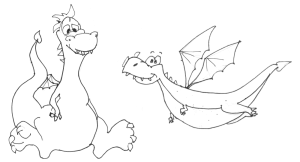106 How do dragons create fire? – Instructor Guide
Instructional guide
This unit is designed to solidify concepts of gastrointestinal variations among species and to tap into student creativity
Intended grade level
- This lesson is intended for students in high school
- Students should review or learn the comparative anatomy of dogs, cattle, horses and rabbits.
- Students should already have a working understanding of the main dietary components of proteins, fats and carbohydrates.
Student learning objectives
- Students should be able to draw, depict and/or explain a reasonable GI tract for dragon, based on their knowledge of a dragon’s diet and the GI tract variants of other species
- Students should be able to contrast herbivore and carnivore GI tracts
- Students should be able to explain the difference between hindgut and foregut fermenters and how the two types vary in their use of nutrients
Lesson Format
This unit is designed for creativity and art supplies are helpful. However, it can be completed with any materials, including pen/ink or computer drawn shapes. The activity should take approximately 30 minutes. Background knowledge may take 1-2 hours to learn and comprehend
- The goal is to create the protagonist in a children’s story. This involves drawing or creating the inner workings of a dragon using a provided or created dragon outline
- Students are encouraged to add in a “fire breathing” component or to consider how fire or smoke might be created
Common misconceptions and challenge points
- Common misconception- animals can digest hay and grass. They cannot. However, some microbes can. These animals have a digestive compartment that houses these microbes and the microbes do the digesting. The animal then uses the microbially produced proteins and vitamins.
- Hindgut vs foregut fermenters: Fermentation is designed to use microbes to build “food” for the herbivore by digesting those grasses and hays that the herbivore cannot digest. If the fermentation is in a foregut, this means the products can directly enter the GI tract as protein, carbohydrates and fats usually do. However, if the fermentation is in a hindgut, this means the products are being built at the end of the GI tract. Cattle are foregut fermenters while rabbits are hindgut fermenters. Rabbits eat their own feces to re-ingest the microbial nutrients.
Knowledge check
- There is no “right” answer for the dragon anatomy. We encourage a low stakes competition or art show to compare the anatomy. Students could craft a short synopsis that explains the primary components of their model or fill out a table comparing the dragon to another species.
- Comparison table example
Dragon Dog Cow Horse Diet GI track description Fermentation Key
| Dragon | Dog | Cow | Horse | |
| Diet | animals (carnivore) | omnivore | herbivore | herbivore |
| GI track description | fire starter near beginning | simple stomach, simple intestines | forestomachs:rumen, reticululm, omasum; then regular GI track | regular GI track but very elongated colon |
| Fermentation | ??? | small amount in colon | foregut (rumen) | hindgut (cecum and colon) |
Learning resources
- Comparative GI anatomy lesson material
- Dragon images to download

Further exploration
Other chapters within this textbook may be interesting for students. Some options can be found linked below:

